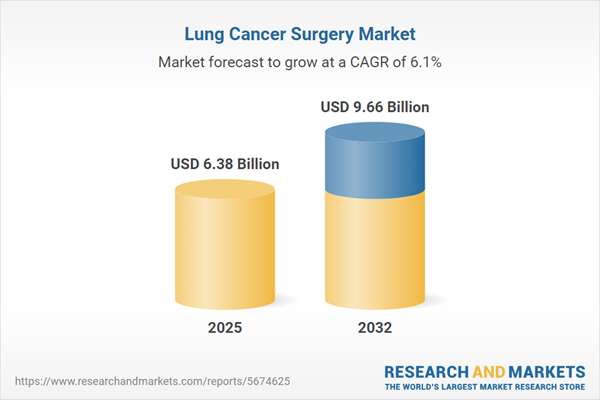Speak directly to the analyst to clarify any post sales queries you may have.
The global lung cancer surgery market is evolving as healthcare organizations seek advanced, efficient clinical solutions to address growing procedural demands. Senior leaders benefit from clear, actionable research to anticipate regulatory adjustments, guide procurement choices, and effectively leverage innovation within surgical care.
Market Snapshot: Global Lung Cancer Surgery Market
Driven by strong uptake of minimally invasive approaches and adoption of sophisticated medical devices, the lung cancer surgery market achieves consistent growth. Providers focus on integrating precision-enabled technologies and modular device platforms to streamline workflows and foster rapid intervention. Standardization of clinical pathways, combined with real-time decision support, underpins care consistency across networks. Ongoing advancements in both precision medicine and surgical modalities are reshaping expectations for outcomes, guaranteeing that healthcare organizations can deliver solutions tailored to local needs and regulatory environments.
Scope & Segmentation
- Surgical Approach: Emphasis centers on minimally invasive procedures, such as robotic-assisted surgery and video-assisted thoracoscopic surgery, which enhance precision and reduce recovery times; open surgery remains important for complex, high-risk cases.
- Product Type: The market includes advanced access devices, trocars, endoscopic instruments, imaging systems with high resolution, energy-based devices including bipolar and electrosurgical options, ultrasonic surgical tools, and stapling equipment designed for sustained safety and workflow efficiency.
- Cancer Type: Primary focus is on non-small cell lung cancer, covering adenocarcinoma, squamous cell carcinoma, and large cell carcinoma, with tailored clinical strategies developed for small cell lung cancer responding to morphological considerations.
- End User: Thoracic oncology hospitals and ambulatory surgical centers adopt standardized protocols and digital management frameworks to drive productivity and ensure treatment consistency in surgical care settings.
- Regions Covered: Amercias, Europe, Middle East, Africa, and Asia-Pacific represent the principal geographical segments. Accelerated adoption is notable in China, India, Japan, South Korea, and Australia, attributed to upgrades in healthcare infrastructure and evolving local policy landscapes.
- Leading Companies: Major players, including Intuitive Surgical, Medtronic, Johnson & Johnson, Stryker, Olympus, KARL STORZ, Becton Dickinson, Boston Scientific, Smith & Nephew, and Zimmer Biomet, steer collaborative innovation, expand market access, and reinforce value for clinical teams via product development and strategic alignment.
Key Takeaways
- Minimally invasive and robot-assisted surgical approaches are impacting clinical standards, contributing to greater procedural efficiency and reliable patient recovery experiences.
- Next-generation imaging technologies and AI-enabled decision support equip surgical teams to manage complex cases with increased accuracy while aiding in real-time interventions.
- Partnership strategies among device manufacturers and technology partners accelerate launches, simplify compliance processes, and facilitate smoother entry into diverse regional markets.
- Simulation-based training and new stapling technologies are supporting advancements in surgical skills and consistent safety improvements for patients across practice settings.
- Procurement and resource approaches align with localized regulations and infrastructure, boosting reliability and resilience within healthcare supply chains.
- Analytics-driven organizational planning enables healthcare providers to regularly optimize workflows, remain responsive to market developments, and develop sustainable reimbursement practices in light of industry changes.
Tariff Impact: Preparing for US Tariff Shifts in 2025
Forthcoming changes to United States medical device tariffs in 2025 require device manufacturers to review operational strategies. Approaches focus on increasing domestic manufacturing capacity and diversifying supplier relationships to mitigate disruption risk. Healthcare providers adopt adaptive procurement models to maintain uninterrupted access to surgical assets and minimize variability in lung cancer surgery resource availability.
Methodology & Data Sources
This report synthesizes perspectives from clinicians and procurement professionals, drawing upon peer-reviewed research, reimbursement documentation, and official procurement data. Regulatory analysis grounds the findings, equipping senior leaders with decision-ready intelligence for shaping effective surgical strategies.
Lung Cancer Surgery Market: Why This Report Matters
- The research enables senior decision-makers to benchmark operations against international lung cancer surgery standards, supporting optimal alignment with leading practice trends.
- Guidance within the report assists in adapting procurement and regulatory processes, improving risk management, and ensuring swift adaptation to market developments.
- Stakeholders gain insights for enhancing technology partnerships, streamlining procurement cycles, and elevating clinical team expertise to sustain competitiveness.
Conclusion
Agile business strategies and technology adoption define future success in lung cancer surgery. Prioritizing innovation and operational excellence positions organizations to deliver stable, high-quality care in a continuously evolving global environment.
Additional Product Information:
- Purchase of this report includes 1 year online access with quarterly updates.
- This report can be updated on request. Please contact our Customer Experience team using the Ask a Question widget on our website.
Table of Contents
3. Executive Summary
4. Market Overview
7. Cumulative Impact of Artificial Intelligence 2025
Companies Mentioned
The companies profiled in this Lung Cancer Surgery market report include:- Intuitive Surgical, Inc.
- Medtronic plc
- Johnson & Johnson
- Stryker Corporation
- Olympus Corporation
- KARL STORZ SE & Co. KG
- Becton Dickinson and Company
- Boston Scientific Corporation
- Smith & Nephew plc
- Zimmer Biomet Holdings, Inc.
Table Information
| Report Attribute | Details |
|---|---|
| No. of Pages | 187 |
| Published | October 2025 |
| Forecast Period | 2025 - 2032 |
| Estimated Market Value ( USD | $ 6.38 Billion |
| Forecasted Market Value ( USD | $ 9.66 Billion |
| Compound Annual Growth Rate | 6.1% |
| Regions Covered | Global |
| No. of Companies Mentioned | 11 |









